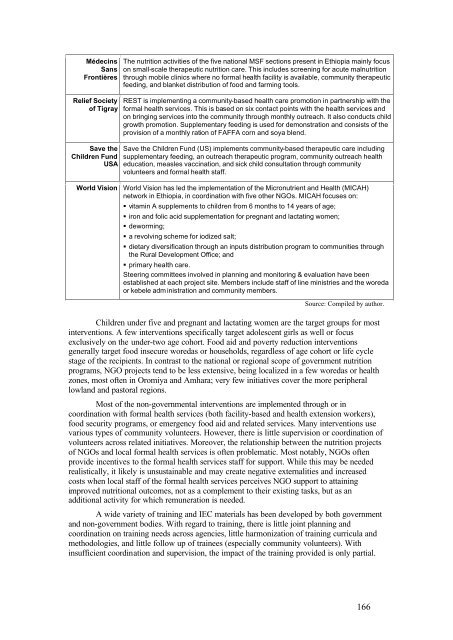An assessment of the causes of malnutrition in Ethiopia: A ...
An assessment of the causes of malnutrition in Ethiopia: A ...
An assessment of the causes of malnutrition in Ethiopia: A ...
Create successful ePaper yourself
Turn your PDF publications into a flip-book with our unique Google optimized e-Paper software.
Médec<strong>in</strong>s<br />
Sans<br />
Frontières<br />
Relief Society<br />
<strong>of</strong> Tigray<br />
Save <strong>the</strong><br />
Children Fund<br />
USA<br />
The nutrition activities <strong>of</strong> <strong>the</strong> five national MSF sections present <strong>in</strong> <strong>Ethiopia</strong> ma<strong>in</strong>ly focus<br />
on small-scale <strong>the</strong>rapeutic nutrition care. This <strong>in</strong>cludes screen<strong>in</strong>g for acute <strong>malnutrition</strong><br />
through mobile cl<strong>in</strong>ics where no formal health facility is available, community <strong>the</strong>rapeutic<br />
feed<strong>in</strong>g, and blanket distribution <strong>of</strong> food and farm<strong>in</strong>g tools.<br />
REST is implement<strong>in</strong>g a community-based health care promotion <strong>in</strong> partnership with <strong>the</strong><br />
formal health services. This is based on six contact po<strong>in</strong>ts with <strong>the</strong> health services and<br />
on br<strong>in</strong>g<strong>in</strong>g services <strong>in</strong>to <strong>the</strong> community through monthly outreach. It also conducts child<br />
growth promotion. Supplementary feed<strong>in</strong>g is used for demonstration and consists <strong>of</strong> <strong>the</strong><br />
provision <strong>of</strong> a monthly ration <strong>of</strong> FAFFA corn and soya blend.<br />
Save <strong>the</strong> Children Fund (US) implements community-based <strong>the</strong>rapeutic care <strong>in</strong>clud<strong>in</strong>g<br />
supplementary feed<strong>in</strong>g, an outreach <strong>the</strong>rapeutic program, community outreach health<br />
education, measles vacc<strong>in</strong>ation, and sick child consultation through community<br />
volunteers and formal health staff.<br />
World Vision World Vision has led <strong>the</strong> implementation <strong>of</strong> <strong>the</strong> Micronutrient and Health (MICAH)<br />
network <strong>in</strong> <strong>Ethiopia</strong>, <strong>in</strong> coord<strong>in</strong>ation with five o<strong>the</strong>r NGOs. MICAH focuses on:<br />
• vitam<strong>in</strong> A supplements to children from 6 months to 14 years <strong>of</strong> age;<br />
• iron and folic acid supplementation for pregnant and lactat<strong>in</strong>g women;<br />
• deworm<strong>in</strong>g;<br />
• a revolv<strong>in</strong>g scheme for iodized salt;<br />
• dietary diversification through an <strong>in</strong>puts distribution program to communities through<br />
<strong>the</strong> Rural Development Office; and<br />
• primary health care.<br />
Steer<strong>in</strong>g committees <strong>in</strong>volved <strong>in</strong> plann<strong>in</strong>g and monitor<strong>in</strong>g & evaluation have been<br />
established at each project site. Members <strong>in</strong>clude staff <strong>of</strong> l<strong>in</strong>e m<strong>in</strong>istries and <strong>the</strong> woreda<br />
or kebele adm <strong>in</strong>istration and community members.<br />
Source: Compiled by author.<br />
Children under five and pregnant and lactat<strong>in</strong>g women are <strong>the</strong> target groups for most<br />
<strong>in</strong>terventions. A few <strong>in</strong>terventions specifically target adolescent girls as well or focus<br />
exclusively on <strong>the</strong> under-two age cohort. Food aid and poverty reduction <strong>in</strong>terventions<br />
generally target food <strong>in</strong>secure woredas or households, regardless <strong>of</strong> age cohort or life cycle<br />
stage <strong>of</strong> <strong>the</strong> recipients. In contrast to <strong>the</strong> national or regional scope <strong>of</strong> government nutrition<br />
programs, NGO projects tend to be less extensive, be<strong>in</strong>g localized <strong>in</strong> a few woredas or health<br />
zones, most <strong>of</strong>ten <strong>in</strong> Oromiya and Amhara; very few <strong>in</strong>itiatives cover <strong>the</strong> more peripheral<br />
lowland and pastoral regions.<br />
Most <strong>of</strong> <strong>the</strong> non-governmental <strong>in</strong>terventions are implemented through or <strong>in</strong><br />
coord<strong>in</strong>ation with formal health services (both facility-based and health extension workers),<br />
food security programs, or emergency food aid and related services. Many <strong>in</strong>terventions use<br />
various types <strong>of</strong> community volunteers. However, <strong>the</strong>re is little supervision or coord<strong>in</strong>ation <strong>of</strong><br />
volunteers across related <strong>in</strong>itiatives. Moreover, <strong>the</strong> relationship between <strong>the</strong> nutrition projects<br />
<strong>of</strong> NGOs and local formal health services is <strong>of</strong>ten problematic. Most notably, NGOs <strong>of</strong>ten<br />
provide <strong>in</strong>centives to <strong>the</strong> formal health services staff for support. While this may be needed<br />
realistically, it likely is unsusta<strong>in</strong>able and may create negative externalities and <strong>in</strong>creased<br />
costs when local staff <strong>of</strong> <strong>the</strong> formal health services perceives NGO support to atta<strong>in</strong><strong>in</strong>g<br />
improved nutritional outcomes, not as a complement to <strong>the</strong>ir exist<strong>in</strong>g tasks, but as an<br />
additional activity for which remuneration is needed.<br />
A wide variety <strong>of</strong> tra<strong>in</strong><strong>in</strong>g and IEC materials has been developed by both government<br />
and non-government bodies. With regard to tra<strong>in</strong><strong>in</strong>g, <strong>the</strong>re is little jo<strong>in</strong>t plann<strong>in</strong>g and<br />
coord<strong>in</strong>ation on tra<strong>in</strong><strong>in</strong>g needs across agencies, little harmonization <strong>of</strong> tra<strong>in</strong><strong>in</strong>g curricula and<br />
methodologies, and little follow up <strong>of</strong> tra<strong>in</strong>ees (especially community volunteers). With<br />
<strong>in</strong>sufficient coord<strong>in</strong>ation and supervision, <strong>the</strong> impact <strong>of</strong> <strong>the</strong> tra<strong>in</strong><strong>in</strong>g provided is only partial.<br />
166
















